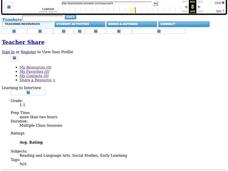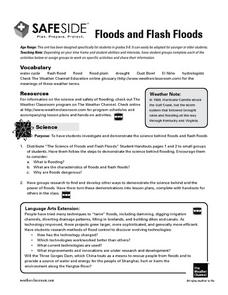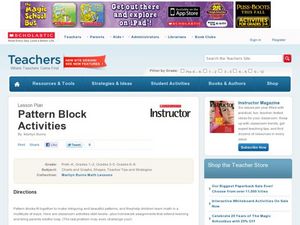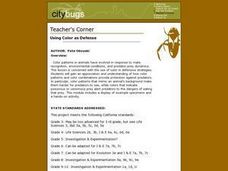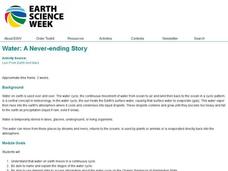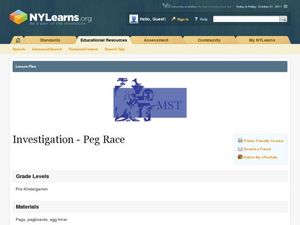Star Wars in the Classroom
Star Wars Geography Unit
What kind of animals live on an ice planet like Hoth? How would the habitat on Tatooine allow different organisms to thrive? Connect social studies, science, and Star Wars in one engaging activity that focuses on the ecosystems...
National Wildlife Federation
It's All in the Name: Weather Versus Climate
What goes up when rain comes down? An umbrella! Activity eight in the series of 12 explores weather and climate. In pairs, participants analyze maps, watch a short video, create a weather forecast, and complete a reading to determine the...
Curated OER
Learning to Interview
An authentic and engaging way to practice literacy skills, this lesson calls for young language arts pupils to conduct interviews with classmates and family members. First, pupils watch as the teacher models the interview process with a...
Noyce Foundation
Granny’s Balloon Trip
Take flight with a fun activity focused on graphing data on a coordinate plane. As learners study the data for Granny's hot-air balloon trip, including the time of day and the distance of the balloon from the ground, they practice...
Virginia Department of Education
Exponents
Expand your knowledge of exponents with an activity that promotes critical thinking and comparison skills. Middle and high schoolers compare numbers written in expanded and exponential form and explain their strategies for solving...
Curated OER
What is the Average Height of Your Class?
In this statistics lesson plan, learners use an on-line form generator create a class-specific form, then complete the form, view a graph and data analysis, and draw conclusions.
Houghton Mifflin Harcourt
Fraction Strips
Identify, compare, and order fractions with a hands-on learning tool. Fraction strips are a great way to help young mathematicians understand and visualize fraction values. The worksheet can be made into an activity in which pupils cut...
Curated OER
Seeing Double
Students develop an intuitive definition for symmetry after viewing a PBS video. They examine asymmetrical patterns and demonstrate their knowledge by changing them to symmytrical.
Curated OER
Toilet Plunger Sundial
Students build a sundial to measure the local noon time. In this third grade science lesson, students build a sundial out of common materials and align to measure the local noon. This lesson is a hands-on tracking of the sun, and allows...
Curated OER
Dragon Genetics ~ Independent Assortment and Genetic Linkage
Imagine a pair of dragons that produce offspring. What percentage of the hatchlings have wings and large antlers? An engaging activity draws genetics learners in, introduces them to alleles, meiosis, phenotypes, genotypes, and...
Curated OER
Life Cycle of the Plant - The Pumpkin
First graders access prior knowledge about pumpkins and read the story Pumpkin, Pumpkin. They will sequence the life cycle of the pumpkin through the use of picture cards and then sing a song about the life cycle of the pumpkin and plant...
Curated OER
Floods and Flash Floods
Junior geologists, hydrologists, or meteorologists simulate what happens during the flooding of a river and demonstrate factors that contribute to flash flooding. This outstanding resource provides a vocabulary list, online resources,...
Science 4 Inquiry
Phases of the Moon
The moon takes just over 27 days to orbit around Earth. Young scientists position themselves as the earth as they rotate around the sun and hold the moon. This allows them to observe the patterns and phases of the moon.
Curated OER
Pattern Block Activities
Young scholars practice various math skills by using manipulative activities. In this math manipulative lesson, students sort shapes, build hexagons, and build shapes using manipulatives. These activities would be great for parent ed...
Curated OER
Using Color as Defense
Learners explore mimicry and crypsis, participate in hands-on predator-prey activity, and practice calculating averages and graph results in histogram.
Curated OER
Water: A Neverending Story
Young scholars investigate the water cycle. In this water cycle science lesson, students participate in a series of activities that demonstrate evaporation, precipitation, and condensation. Young scholars describe their...
Curated OER
Connections: Peddling Petals
Students identify various patterns. In this patterns lesson, students assemble paper flowers by using patterns. Students discuss how they constructed their flower.
Curated OER
9th Grade Transition Algebra
Ninth graders examine mathematical patterns. For this algebra lesson, 9th graders collaborate to think outside the box and share solutions to problems they have encountered. Students use popsicle sticks to solve various building problems...
Curated OER
Independent Investigation
Students classify objects. In this math lesson, students sort and classify objects based on their characteristics. Students identify characteristics of objects.
Curated OER
Investigation: Peg Race
Students explore competition by participating in a peg race. In this pattern creation lesson, students utilize an egg timer and pegs or colored cubes to create patterns quickly while competing with fellow classmates to finish first....
Curated OER
Animal Babies on the Farm
Students observe pictures of farm animals and name the animals. They match the animals to their offspring in a number of matching activities.
Curated OER
Ballhandling Skills
Students practice handling the ball and becoming comfortable passing. In groups, they perform different movements and complete patterns with the ball. To end the lesson, they pass the ball to their partners and complete a short assessment.
Curated OER
Glad To Meet You
Students explore patterns. In this patterns lesson, students explore patterns in hand-shaking scenarios. Students work in groups to predict and record the number of handshakes that occur in a group.
Curated OER
Number Scrolls
Students write the number line. In this numbers instructional activity, students write numbers in numeric order on a number scroll. They find patterns within this number line.




